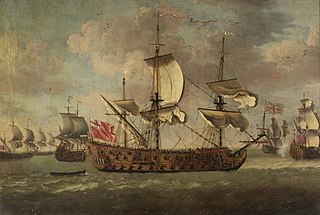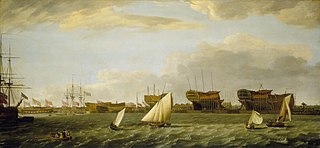
HMS Caledonia was a 120-gun first-rate ship of the line of the Royal Navy, launched on 25 June 1808 at Plymouth. She was Admiral Pellew's flagship in the Mediterranean.

HMS Hero was a 74-gun third rate of the Royal Navy, launched on 18 August 1803 at Blackwall Yard.

HMS Britannia was a 100-gun first rate ship of the line of the Royal Navy, built by Phineas Pett II at Chatham Dockyard, and launched on 27 June 1682.

HMS Warspite was a 70-gun third-rate ship of the line of the Royal Navy, launched in 1666 at Blackwall Yard. This second Warspite was one of the five ships designed to carry more provisions and lower deck guns higher above the water than French and Dutch equivalents. In 1665 the Second Anglo-Dutch War had begun and on 25 July 1666 Warspite was one of 23 new English warships helping to beat a Dutch fleet off North Foreland, Kent. She won again distinction on Christmas Day 1666 as senior officer's ship out of five sent to protect an important convoy of naval stores from the Baltic. Warspite next took part in the first action of the Third Anglo-Dutch War on 28 May 1672 off Southwold Bay, Suffolk. This desperate 14-hour battle, generally known as Solebay, was a drawn fight; but Warspite successfully fended off a pair of Dutch fire ships exactly as she had done off North Foreland. By 1685, she was mounting only 68 guns.

HMS Falkland was a 50-gun fourth-rate ship of the line of the Royal Navy, built by Holland of New Castle, New Hampshire, and purchased by the navy in 1696.

HMS St Michael was a 90-gun second rate ship of the line of the Royal Navy, built by John Tippetts of Portsmouth Dockyard and launched in 1669.

HMS Swiftsure was a 70-gun third-rate ship of the line of the Royal Navy, built by Sir Anthony Deane at Harwich, and launched in 1673. By 1685 she had been reduced to a 66-gun ship.

HMS Plymouth was a 52-gun third-rate frigate, built for the navy of the Commonwealth of England and launched at Wapping in 1653. By 1677 her armament had been increased to 60 guns.
HMS Dreadnought was a 52-gun third-rate ship of the line, in service with the Royal Navy from 1660 to 1690.

HMS Suffolk was a 70-gun third-rate ship of the line of the Royal Navy, built by contract of 20 February 1678 by Sir Henry Johnson at Blackwall. She participated in the War of the English Succession 1689 - 1697, in the Battles of Beachy Head and Barfleur. She was rebuilt in 1699. She was actively involved in the War of Spanish Succession 1702 - 1713. Her later career was as guard ship duties, deployments to the Baltic Sea and the West Indies. She was finally broken in 1765 after lying in Ordinary for almost twenty years.
HMS Deptford was a 50-gun fourth-rate ship of the line of the Royal Navy, launched at Woolwich Dockyard in 1687. This was the second of three 50-gun ships ordered in 1682/3.

HMS Boyne was an 80-gun third-rate ship of the line of the Royal Navy, launched at Deptford Dockyard on 21 May 1692.
HMS Winchester was a 50-gun fourth rate ship of the line of the Royal Navy, one of eight such ships authorised by the Navy Board to be newly built ; the others were the Hampshire, Dartmouth, Salisbury, Worcester, Jersey, Carlisle and Tilbury. The contract for the Winchester was signed with shipbuilders John and Richard Wells in 1696, for the ship to be built in their yard at Greenland North Dockyard, in Rotherhithe, and she was launched there on 17 March 1698.
Blackwall was a 50-gun fourth-rate ship of the line of the English Royal Navy, one of four ordered in September 1694 to be built by commercial contracts; eight further ships of this type were ordered on 24 December. The Blackwall was built by Sir Henry Johnson's Blackwall Yard and launched on 6 July 1696.

HMS Guernsey was a 50-gun fourth rate ship of the line of the Royal Navy, one of four ordered in September 1694 to be built by commercial contracts; eight further ships of this type were ordered on 24 December. The Guernsey was built by Sir Henry Johnson's Blackwall Yard and launched on 6 July 1696.
HMS Warwick was a 50-gun fourth rate ship of the line of the Royal Navy, one of four ordered in September 1694 to be built by commercial contracts; eight further ships of this type were ordered on 24 December. The Warwick was built by Robert and John Castle at their Deptford shipyard and launched on 20 August 1696.

HMS Dreadnought was a 60-gun fourth rate ship of the line of the Royal Navy, built according to the 1733 proposals of the 1719 Establishment at Deptford, and was launched on 23 June 1742. Dreadnought served until 1784, when she was sold out of the service.
HMS Leopard was a 50-gun fourth rate ship of the line of the Royal Navy, built according to the 1733 proposals of the 1719 Establishment at Blackwall Yard, and launched on 30 October 1741.
HMS Norwich was a 50-gun fourth rate ship of the line of the Royal Navy, built according to the 1741 proposals of the 1719 Establishment at Blackwall Yard, and launched on 4 July 1745.
HMS Preston was a 50-gun fourth rate ship of the line of the Royal Navy, built at Deptford Dockyard by Adam Hayes to the draught specified in the 1745 Establishment, and launched on 7 February 1757.












